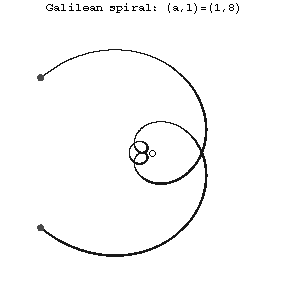Difference between revisions of "Galilean spiral"
From Encyclopedia of Mathematics
(Importing text file) |
(TeX) |
||
| Line 1: | Line 1: | ||
| + | {{TEX|done}} | ||
A plane curve whose equation in polar coordinates is | A plane curve whose equation in polar coordinates is | ||
| − | + | $$\rho=a\phi^2-l,\quad l\geq0.$$ | |
| − | The spiral is symmetric with respect to the polar axis (see Fig.) and has a double point at the pole with tangents forming angles equal to | + | The spiral is symmetric with respect to the polar axis (see Fig.) and has a double point at the pole with tangents forming angles equal to $\pm\sqrt{l/a}$ with the polar axis. |
<img style="border:1px solid;" src="https://www.encyclopediaofmath.org/legacyimages/common_img/g043080a.gif" /> | <img style="border:1px solid;" src="https://www.encyclopediaofmath.org/legacyimages/common_img/g043080a.gif" /> | ||
| Line 9: | Line 10: | ||
Figure: g043080a | Figure: g043080a | ||
| − | The polar axis of a Galilean spiral contains infinitely many double points, for which | + | The polar axis of a Galilean spiral contains infinitely many double points, for which $\rho=ak^2\pi^2-l$, where $k=1,2,\ldots$. The Galilean spiral is a so-called algebraic spiral (cf. [[Spirals|Spirals]]). Named after G. Galilei (1683) in connection with his studies on the free fall of solids. |
====References==== | ====References==== | ||
<table><TR><TD valign="top">[1]</TD> <TD valign="top"> A.A. Savelov, "Planar curves" , Moscow (1960) (In Russian)</TD></TR></table> | <table><TR><TD valign="top">[1]</TD> <TD valign="top"> A.A. Savelov, "Planar curves" , Moscow (1960) (In Russian)</TD></TR></table> | ||
Revision as of 11:12, 26 July 2014
A plane curve whose equation in polar coordinates is
$$\rho=a\phi^2-l,\quad l\geq0.$$
The spiral is symmetric with respect to the polar axis (see Fig.) and has a double point at the pole with tangents forming angles equal to $\pm\sqrt{l/a}$ with the polar axis.

Figure: g043080a
The polar axis of a Galilean spiral contains infinitely many double points, for which $\rho=ak^2\pi^2-l$, where $k=1,2,\ldots$. The Galilean spiral is a so-called algebraic spiral (cf. Spirals). Named after G. Galilei (1683) in connection with his studies on the free fall of solids.
References
| [1] | A.A. Savelov, "Planar curves" , Moscow (1960) (In Russian) |
How to Cite This Entry:
Galilean spiral. Encyclopedia of Mathematics. URL: http://encyclopediaofmath.org/index.php?title=Galilean_spiral&oldid=32536
Galilean spiral. Encyclopedia of Mathematics. URL: http://encyclopediaofmath.org/index.php?title=Galilean_spiral&oldid=32536
This article was adapted from an original article by D.D. Sokolov (originator), which appeared in Encyclopedia of Mathematics - ISBN 1402006098. See original article